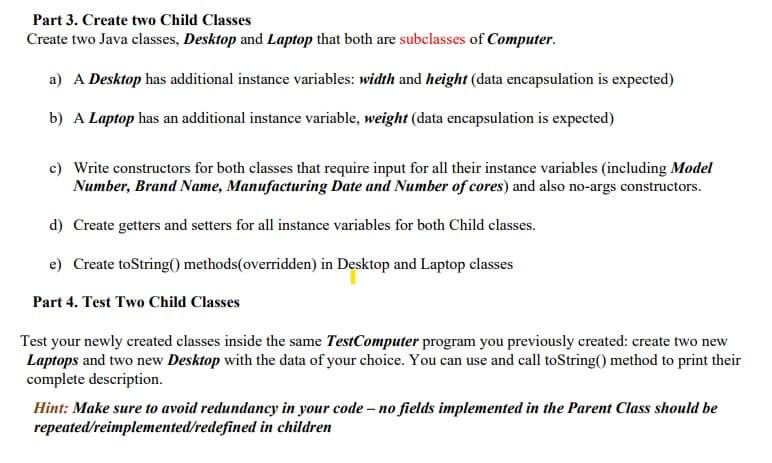Part 3. Create two Child Classes Create two Java classes, Desktop and Laptop that both are subclasses of Computer. a) A Desktop has additional instance variables: width and height (data encapsulation is expected) b) A Laptop has an additional instance variable, weight (data encapsulation is expected) c) Write constructors for both classes that require input for all their instance variables (including Model Number, Brand Name, Manufacturing Date and Number of cores) and also no-args constructors. d) Create getters and setters for all instance variables for both Child classes. e) Create toString() methods(overridden) in Desktop and Laptop classes Part 4. Test Two Child Classes Test your newly created classes inside the same TestComputer program you previously created: create two new Laptops and two new Desktop with the data of your choice. You can use and call toString() method to print their complete description.
Please add the code after this one. The code has to be in java eclipse. Please add comments in what you are doing. I'll appreciate it
public class Computer {
private String ModelNumber;
private String BrandName;
private String manufacturingDate;
private int NumberOfCores;
//Constructor a
public Computer() {
}
//Construct a computer object with model, BrandName, NumberOfCores
Computer (String ModelNumber, String BrandName, String manufacturingDate, int NumberOfCores){
this.ModelNumber=ModelNumber;
this.BrandName=BrandName;
this.manufacturingDate=manufacturingDate;
this.NumberOfCores=NumberOfCores;
}
//generate getters/setters
public String getModel() {
return ModelNumber;
}
public void setModel(String ModelNumber) {
ModelNumber = ModelNumber;
}
public String getBrandName() {
return BrandName;
}
public void setBrandName(String brandName) {
BrandName = brandName;
}
public String getManufacturingDate() {
return manufacturingDate;
}
public void setManufacturingDate(String manufacturingDate) {
this.manufacturingDate = manufacturingDate;
}
public int getNumberOfCores() {
return NumberOfCores;
}
public void setNumberOfCores(int numberOfCores) {
NumberOfCores = numberOfCores;
}
public String toString() {
return "\nModelNumber: "+ ModelNumber + "BrandName: "+ BrandName +"Created on "+ manufacturingDate +
"NumberOfCores: "+ NumberOfCores ;
}
public String Output() {
return "Output is from method present in ComputerObject's Class";
}
}

Trending now
This is a popular solution!
Step by step
Solved in 4 steps with 3 images









